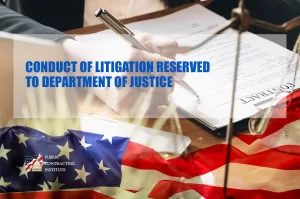The Corps of Engineers learned the hard way that 28 U.S.C. § 516 means what it says, and that the Department of Justice has the right to conduct (and settle) litigation to which the United States is a party or is interested in. This section of the U.S. Code provides that:
Except as otherwise authorized by law, the conduct of litigation in which the United States, an agency, or officer thereof is a party, or is interested, and securing evidence therefor, is reserved to officers of the Department of Justice, under the direction of the Attorney General.
In U.S. Coating Specialties & Supplies, LLC, ASBCA No. 58145, 17-1 BCA ¶ 36710, the government sought to terminate U.S. Coating’s contract for default, and filed a motion for summary judgment, asserting that an alleged prior oral agreement between the appellant and the Assistant U.S. Attorney (“AUSA”) during appellant’s Chapter 11 bankruptcy proceedings was invalid because the AUSA lacked actual authority to enter into that alleged agreement. The Board denied the motion and ruled that the AUSA had authority pursuant to 28 U.S.C. § 516.
The Corps of Engineers awarded U.S. Coating a contract to construct an office building and computer facility in Vicksburg, MS. A year and a half into the contract, U.S. Coating sought Chapter 11 bankruptcy protection in the Bankruptcy Court. During the bankruptcy proceedings, the AUSA, on behalf of the U.S. attorney, filed responses to motions for the U.S. and the agency. Eventually, the Bankruptcy court ordered that the U.S. Coating contract had been rejected. Immediately following that court order, the Contracting Officer terminated the contract for default, asserting that U.S. Coating’s consent to rejection of the contract had constituted an anticipatory repudiation.
Not so fast, said U.S. Coating, which move to vacate the order, asserting that its consent to the settlement was based on representations by the AUSA that the Corps would terminate its contract for “reasons other than default” (presumably, for convenience). U.S. Coating appealed from the Contracting Officer’s default termination decision, and the Board considered the appeal. The AUSA filed an affidavit with the Board stating that during negotiations prior to the Bankruptcy court order, he “never promised anyone that the Corps would terminate the contract for convenience if U.S. Coating rejected the contract in bankruptcy.” U.S. Coating, however, filed three affidavits (of its President/ CEO and two employees) stating that during the negotiations with the AUSA, the company never consented to a default termination. The company agreed to lift the automatic stay only on the condition that the contract would be terminated only for convenience.
The Government argued that even if U.S. Coating’s allegation of some type of prior oral agreement with the AUSA to terminate the contract for convenience were true, the AUSA lacked actual authority to bind the government—only the contracting officer had that authority, and it had not been delegated to the AUSA. The Board noted that the Corps’ argument regarding the authority of the AUSA missed the point because it failed to acknowledge the statutory delegation of settlement authority to the U.S. Department of Justice pursuant to 28 U.S.C. § 516. As a result of the U.S. Government bankruptcy filing, the litigation at the Bankruptcy Court was under the control of the Department of Justice. U.S. Coating’s bankruptcy filing imposed an automatic stay pursuant to law, prohibiting the contracting officer from commencing administration action or proceeding against U.S. Coating. Therefore, the Corps could not terminate the contract for default without the permission of the Bankruptcy Court. In fact, the AUSA, as the authorized representative of the Attorney General, possessed the exclusive authority to settle matters in litigation before the U.S. bankruptcy courts—and no delegation from the contracting officer was required.
U.S. Coating won this round of the battle, and the Board refused to grant summary judgment for the Corps of Engineers. The Board concluded that further development of the record was needed, specifically the facts surrounding the parties’ negotiations at the Bankruptcy Court.
The takeaway is simple: when you litigate with the Government in U.S. Courts, the AUSA who handles the case possesses exclusive authority to conduct the case or to settle. Normally, such a settlement would be discussed with the agency, and the agency might object. But the final decision lies with the Department of Justice, and its authorized AUSA who is handling the case.
This principle applies to litigation of either bid protests or contract claims at the U.S. Court of Federal Claims (“COFC”). At the COFC, a Department of Justice (“DOJ”) attorney is always listed as the counsel for the United States (the defendant). At the COFC, Agency counsel is normally as “Of Counsel” but it is the DOJ attorney who can conduct or settle the case, even over objections of the Agency counsel. Any settlement discussions must include the DOJ attorney, otherwise there can be no deal at all.

